Private Moments With Rock Icons Not Meant For The Screen
By | November 17, 2022
Albert King lighting a cigarette for Jim Morrison.
Musical icons unleash their on-stage personas to the fullest extent for throngs of rabid fans. However, those same larger-than-life characters often act very differently behind the scenes. Whether it's quietly chumming it up with fellow celebrities or releasing their inner child remnants in zany ways, even musical legends act silly. Here’s some behind the scenes moments of some of music’s biggest stars.
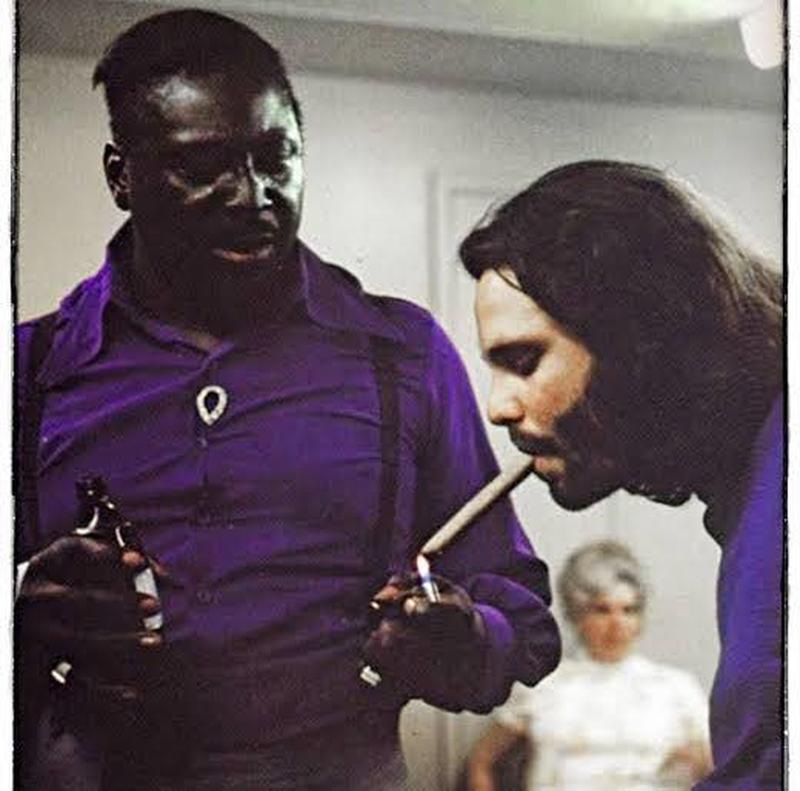
Along with B.B. King and Freddie King, Albert King who is unrelated, were known as the “Kings of Blues.” Once nicknamed the "The Velvet Bulldozer," the giant baron of blues towers over Jim Morrison, the lead singer for The Doors Morrison ranked among the most influential frontman in music history. Despite his tragic early passing, the legacy of The Doors still endures. Along with Ray Manzarek, Morrison founded The Doors in Venice, California. Their number one single “Light My Fire” took them from obscurity to the top.
Alice Cooper drinking a beer with Colonel Sanders.
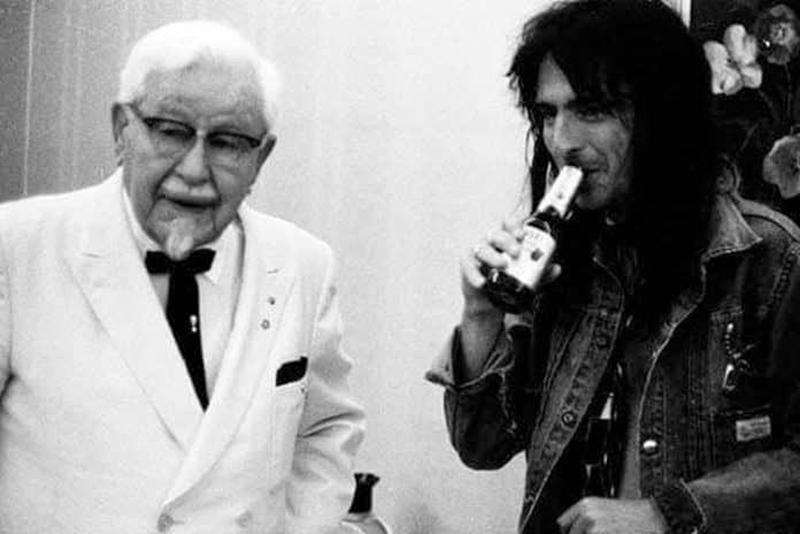
As Cooper once said about the fateful meeting:
Here comes this nice old man in a white suit. Suddenly I realize that this is the Hannibal Lecter of chickens. I have the death of exactly one chicken on my hands, and this guy has a score of 10 billion. Yet everyone loves this guy, and hates me for being a chicken killer! The irony of the two of us being in the same room at the same time was not lost on either me or the Colonel.
Bob Dylan and Muhammad Ali.

On December 8,1975 “The Voice of a Generation” met “The People’s Champion.” The iconic meeting of masters came backstage during a charity event for Hurricane Relief. Ali gifted Dylan a boxing glove and apparently made quite the impression on the rock star. When Ali passed years later, Dylan wrote of the boxer:
If the measure of greatness is to gladden the heart of every human being on the face of the earth, then he truly was the greatest.
Bob Marley, Mick Jagger, and Peter Tosh, New York, 1978.

This iconic meeting of musical geniuses came about backstage after a Rolling Stones concert at the Palladium Theatre. Jagger was a huge Marley fan. He once said that before concerts he would dance around to some of Marley’s magic. He also said that “Bob Marley got so big, and that probably annoyed him.” Perhaps Jagger should relisten to some of Marley's music because as the legendary reggae singer strongly believed, “Live for yourself and you will live in vain; Live for others, and you will live again.”
Chuck Berry, Bob Dylan, James Brown.

This incredible array of musical genius convened at the Rock & Roll Hall of Fame in 1995. Inductees that year included Led Zeppelin, Janis Joplin, Neil Young, Al Green, among others. Dylan himself once said that his songs, “didn’t get here by themselves.” In this picture, two of his influences enjoy “The Bard’s” company, telling him how their music helped create his “new poetic expressions within the great American song tradition,” as Dylan put it.
Jesse Jackson and Marvin Gaye hooping in 1976.

In a picture that oozes the ‘70s, Jackson and Gaye play what looks to be a competitive game of one on one. Between Jackson’s afro, their shorts, and Gaye’s high socks, you can tell this showdown occurred during the Disco era. Gaye helped create Motown Records as their first in-house session player. Thanks to his foundation shaping contributions, he became known as "Prince of Motown."
Jimi Hendrix jamming with the Monkees, 1967.
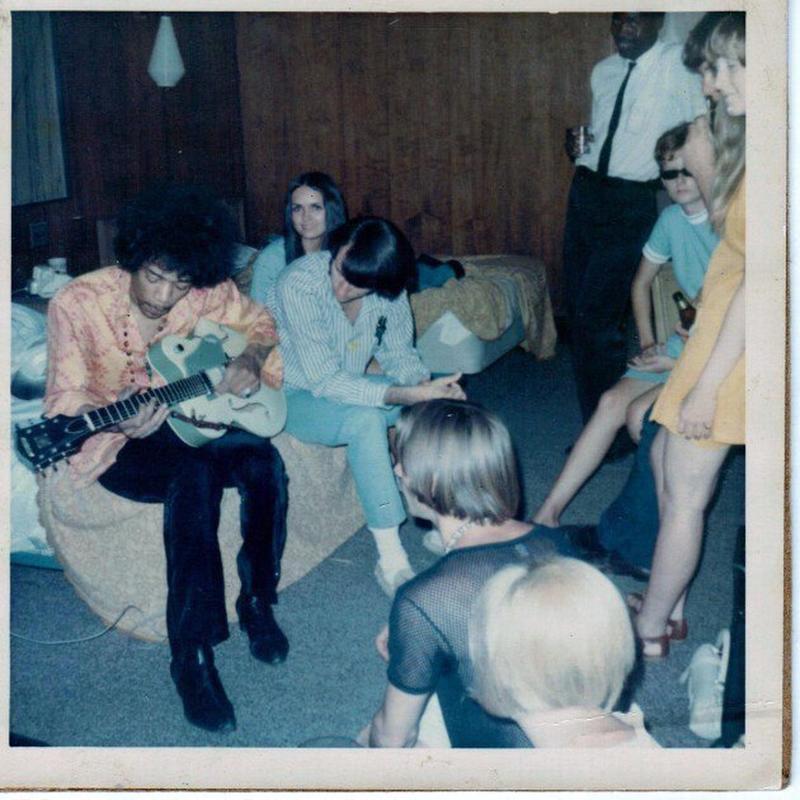
In a combination that, on the surface, went together like oil and water, Jimi Hendrix and the Monkees went on tour together in ‘67. The Monkees who represented the innocent, clean-cut side of music obviously clashed with the debaucherous styling of Young Jimmy. In what seems slightly ridiculous today, Jimi opened for the Monkees and not the other way around. It didn’t help matters that Hendrix called their music “dishwater.” He only lasted eight tour stops before walking off stage in Queens, New York.
Johnny Cash outside Folsom Prison, 1968.

In his first live album, Cash performed in front of the inmates at Folsom prison. The live show from the infamous penitentiary was something he wanted to do dating back to 1955 after he debuted his "Folsom Prison Blues." However, those in charge of Columbia Records shied away from the idea, likely due to his rash of drug problems. Nevertheless, in ‘67 he got his wish, performing two shows for the incarcerated.
Keith Richards at the Seattle airport while on the Stones’ tour of the USA.

The co-founder, guitarist, and infamous drug aficionado of The Rolling Stones trolled a sign calling for a Drug-Free America. A few years later, Richards was arrested in Arkansas in a van full of drugs. As he said:
All you had to do was pop the panels, and there were plastic bags full of coke and grass, peyote and mescaline.
Thankfully, the local judge let them go after taking the guitarist's hunting knife and photo with Richards.
Keith Richards, James Brown and John Belushi, Studio 54, 1980.

In 1980, three men who never said no to a good time got together at one of New York City’s most notorious hangouts. One can only imagine what this trio got up to that night but you know it was crazy fun. Richards said of Brown:
James was very generous and kind with me and he wasn’t kind with everybody. I really appreciated that. I always studied him and the way he moved, the way he always gave his best and always changed up his style.
Louis Armstrong after a concert in Denmark in 1955.

Louis Armstrong ranked among the most influential figures in Jazz history. Over five decades his music continually changed the game with his innovative trumpet and cornet skills. Apparently, the people of Denmark loved his music so much that in 1955 this particular crowd wouldn't let him end. Louis kept on coming out to take bows until he finally made his point by coming out one last time in his bathrobe.
A young Michael Jackson and Stevie Wonder at the Motown Studios, 1974.
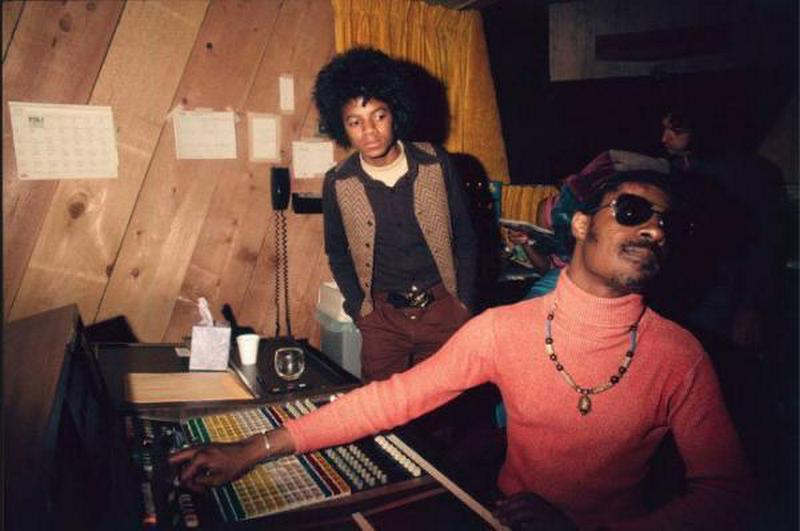
The two musical prodigies met while working together on "We Are the World." Wonder wrote about Jackson:
I first met Michael when I was in Detroit. He came to Motown, and they were talking about this boy from Gary, Indiana, and the Jackson 5, and everyone was excited. He must have been around 9 or 10 then, and I definitely felt that he would be someone. You heard the voice, and all he could do was grow. And that's what he did.
Miles Davis.

The “Prince Of Darkness” remains one of the most influential and celebrated figures in Jazz history. Over five decades the maestro of jazz developed a variety of new sounds with the evolution of cool jazz, orchestral jazz collaborations, and even Spanish influenced music. He jammed with some of the all time greats like Charlie Parker, who helped give Davis his start, and John Coltrane. His “Kind of Blue” still ranks as one of the most popular jazz albums ever.
Muhammad Ali and The Beatles, 1964.

In February of 1964, The Beatles arrived in America to an insane level of fanfare which could only be described as Beatlemania. Just 11 days into their trip, their managers ushered them into a boxing gym in Miami for a photo op with a young boxer named Cassius Clay. Ironically, the Beatles were fans of Sonny Liston and John Lennon even called Ali, the “loudmouth who’s going to lose.”
Neil Young, 1973.

The Canadian-American singer who got his start in Winnipeg of all places made his bones in Los Angeles with Buffalo Springfield alongside Stephen Stills and Richie Furay. His resumé of top albums includes “Everybody Knows This Is Nowhere”, “After the Gold Rush,” “Harvest,” “On the Beach” and “Rust Never Sleeps”. Those all-timers helped garner several Grammys and twice received induction into the Rock & Roll Hall of Fame, once as a solo artist and the second time as a member of Buffalo Springfield.
One of the first pictures ever taken of Black Sabbath, 1968.

The English rock band formed in Birmingham featured guitarist Tony Lommi, drummer Bill Ward, bassist Geezer Butler, and of course, vocalist Ozzy Osbourne. This group of diverse talents helped define the genre with their albums Black Sabbath, Paranoid, and Master of Reality. The group suffered endless lineup changes as Lommi remained the only constant through the band’s history. Osbourne famously left to start biting off bat’s heads in ‘79.
Paul and Linda McCartney with John Lennon and Yoko Ono at The Beatles’ final photography session, Tittenhurst Park, 22 August 1969.

The fateful final photo session of perhaps the most famous band in history took place on the grounds of Lennon’s home. The band had just finished a recording session a few days earlier but the group remained unaware of the finality of the proceedings. As Ringo Starr said, “It was just a photo session. I wasn’t there thinking, ‘OK, this is the last photo session.”
The Doors posing for the cover photo of their “Waiting for the Sun” album, 1968.

Snapped while overlooking a cliff in Los Angeles’ Laurel Canyon, this picture became the cover for The Doors all-time best selling album. “Waiting for the Sun” flew to the top of the charts and held on to the top stop for four weeks, giving the group their only #1 album. It featured "Hello, I Love You," a number one single for two weeks and "The Unknown Soldier."
Willie Nelson at the White House in 1977.

This picture of jovial-looking Nelson preceded a historical night in White House history. Apparently, Nelson and President Carter joked about his recent arrest in the Bahamas for marijuana. But the night of surprises wasn’t over. According to Nelson, “Chip Carter took me down into the bottom of the White House, where the bowling alley is,” before the pair went to the roof to spark a joint. “It’s really pretty nice up there.”
When Metallica and Van Halen toured together, 1988.

For “The Monsters of Rock” summer tour Van Halen, Metallica, and other heavy hitters got together for a 23 state tour that deafened youths across the country. 971 tons of equipment traveled around the country to the delight of metalheads and Metallica’s James Hetfield. Hetfield remembered hearing Van Halen for the first time and thinking:
Whoa, what is that? That really made my hair stand up. Back when I was growing up Van Halen was the heaviest we had in California.
AC/DC two years before “High Voltage”, 1974

From “Highway to Hell” or “Back in Black” AC/DC brought the Australian thunder for decades. The versatility of their self-described “rock and roll” goes far beyond thrilling fans and destroying eardrums. In Australia, researchers have found positive results using “Thunderstruck” to fight cancer! And the United States military even used AC/DC on volume “deafen” to force Panamanian dictator General Manuel Noriega from hiding.
Bruce Springsteen and the E Street Band trying their hand at pinball, 1978.

The Boss and the E Street Band go back to 1972 when they became Springsteen’s go-to backing band. They themselves received the ultimate recognition when the Rock and Roll Hall of Fame inducted them as part of the 2014 class. The eight-person crew consisted of guitarists Steven Van Zandt, Nils Lofgren, and Patti Scialfa, keyboardists Danny Federici and Roy Bittan, bassist Garry Tallent, drummer Max Weinberg, and saxophonist Clarence Clemons.
Thick as thieves, Buddy Holly and Little Richard.

These two lived wildly different lives but still changed music forever. Little Richard reveled in, by any account, the wildest life imaginable. “The Bronze Liberace” sampled every level of debauchery known to man and some probably previously unknown before him. Holly was married in his early 20s before tragically dying in an airplane accident. Nevertheless, he managed to influence the world decades after his passing, right down to his glasses.
David Gilmour, Pink Floyd. Live At Pompeii 1971.

Pink Floyd always tripped to their own essence and “Pink Floyd: Live at Pompeii” embodied that trailblazing ethos. The concert documentary directed by Adrian Maben centered around 4 days of live music at the ancient Roman amphitheater in Pompeii, Italy. However, there was no crowd outside of the film crew. Despite these quirky decisions, many bands followed the band’s lead, creating their own live sans crowds.
In the studio with Dean, Frank, and Sammy.

The Chairman of the Board, the “King of Cool,” and Mister Show Business were the three most famous members of the “Rat Pack.” Ironically, Sinatra hated that particular nickname. Apparently, the “King of Cool” was literally a closet comic book fan, probably afraid to ruin that perfect moniker. But of course nothing could stop Mr. Show Biz, even after losing an eye in a car accident.
Elvis and his many adoring fans.
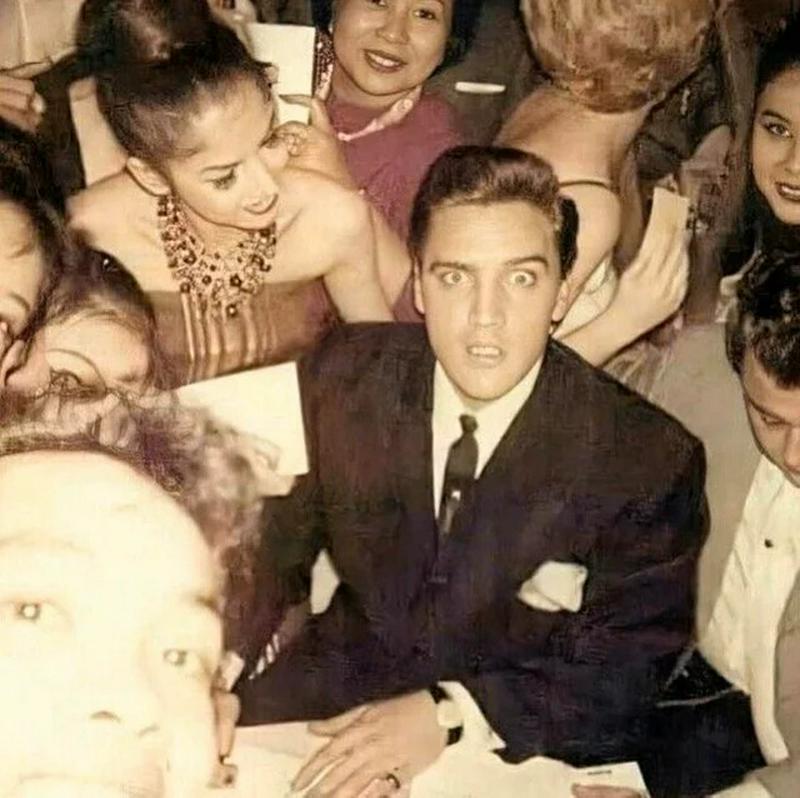
Elvis The King whose hip thrusts paralyzed a nation melded pop music with country, gospel, and R&B to earn his nickname. Despite harsh reviews like "He cannot sing and his whole performance is crude and disgusting," and "in a comparatively short time he will be forgotten," the King reigned. He ruled to the point that even many decades after his death his music still sells.
Frank Zappa hanging with the folks, 1970.

The prodigious and innovative musician who pushed the boundaries of sound with his experiments released an incredible 60 albums! He even played a bad guy on Miami Vice and clearly cared for his parents. Ironically, a "conspiracy to commit pornography" charge, which amounted to him simulating erotic noises for undercover agents, actually kept him out of Vietnam. Did police really have nothing better to do than ask people to moan into microphones?
In 1977, photographer Robert Whitman was hired to take some shots of an unknown 19-year-old musician called Prince Rogers Nelson.

With a legal name like Prince how can you not live a life completely different from every other person? The diminutive musical genius, who still managed to play high school basketball, wrote “Funk Machine" at age seven. He also produced his own album at 17, which sold two million albums worldwide, making him the youngest producer in Warner Bros. history.
James Brown in Augusta, Georgia, 1979.

Brown managed to become the Godfather of Funk and Soul thanks in part to being “The Hardest Working Man in Show Business”. His “Funky Drummer” remains the most sampling cut of all time while hits like “Sex Machine” and “It’s a Man’s World” changed music forever. Amazingly, it all started with an arrest for robbery at 15 and a 8 to 16 year sentence since he was tried as an adult. Thankfully, a gospel group saw his talent and helped reduce that sentence to three years in their custody.
Jimi Hendrix at the Monterey Pop Festival, 1967.

Considered the greatest electric guitarist of all time by many, Hendrix laid his otherworldly creativity upon audiences that couldn’t believe their ears. The left handed guitar god thrived despite simply taking right handed guitars and rearranging the strings. We’re no experts but apparently that’s like playing golf holding the wrong end of the club. It still took Hendrix going over to the UK where his unique talents were first appreciated.
Johnny Cash talking with a handful of inmates during his visit to Cummins Prison in Arkansas. April 10, 1969.

Cash famously played at Folsom Prison but that wasn’t the only time Cash put on a show for the incarcerated. He also put on bangers at San Quentin, Cummins, and Huntsville Prisons. Dr. Colin Woodward, an archivist at UALR’s Center for Arkansas History and Culture believed that Cash brought an awareness to the deplorable conditions. “I think he really identified with prisoners and he wanted to shed light on the need for reform, the need for change.”
Lemmy in jean shorts with a samurai sword.

The lead singer, bassist, and founder of Motörhead obviously enjoyed life a bit differently. The mutton chopped one of a kind worked as a roadie for Jimi Hendrix and “The Nice.” Although his style in no possible way resembled the Beatles, he grew up idolizing the band like every other Brit. He got his break singing vocals for the prog-rock band, Hawkwind, but was fired after an arrest on drug charges. That same year he founded Motörhead.
American country blues singer, songwriter, and guitarist Lightnin Hopkins in the 1950s.

In 2010 Rolling Stone ranked Samuel John "Lightnin" Hopkins as the 71st greatest guitarist of all time. Even more impressively, his music influenced legends like Townes Van Zandt, Hank Williams, Jr., and Stevie Ray Vaughan. In fact, Vaughan’s Grammy winning "Rude Mood" took direct inspiration from Hopkins’ "Hopkins' Sky Hop. Music historian Robert "Mack" McCormick called him "The embodiment of the jazz-and-poetry spirit representing its ancient form in the single creator whose words and music are one act."
Lou Reed in New York, 1974.

It is said that “The Velvet Underground didn't sell many records, but everyone who bought one went out and started a band.” Lou Reed was the lead singer and songwriter for that highly influential but commercially unsuccessful band. It’s worth noting that the enigmatic Andy Warhol managed The Velvet Underground and perhaps that factored into the lack of sales. The iconic artist did instill the band as a fixture at “The Factory,” the seminal hot spot of New York in the ‘70s.
Nirvana playing in a pool for the album cover for Nevermind, 1991.

“Nevermind” sent shockwaves through the music world in ‘91 to the tune of 30 million copies worldwide. Overnight Nirvana turned into a sensation; its unique album cover played a part in their success. Kurt Cobain originally wanted a baby being born underwater but the artist Robert Fisher said, “There’s no way we can make an album cover out of this. I couldn’t find any really good pictures and they were all way too graphic to use.”
Pink Floyd looking very at home in the streets of Amsterdam, 1968.

What better place for the foundational psychedelic rock group Pink Floyd to perform than the boisterous and unrestrained city of Amsterdam. It’s hard to imagine a soundtrack that fits the inner workings of that city better than “The Dark Side of the Moon.” The band clearly loved the Netherlands, playing an astounding 40 shows in the country and undoubtedly, the Dutch loved them back.
Sister Rosetta Tharpe, the Godmother of Rock & Roll.

In the early days of rock and roll, many major acts fell by the wayside due to gender or ethnicity. Rosetta Tharpe remains one of the most influential rock and roll trailblazers in history. Her music influenced legends like Chuck Berry, Elvis Presley, Jerry Lee Lewis, Eric Clapton, Johnny Cash, and Little Richard just to name a few. She became one of the first to use heavy distortion on her electric guitar. She also pushed gospel music into the mainstream with hits like "This Train".
Stevie Nicks working on Rumours, 1976.

With the incredible relationship dramas happening around the time of “Rumours,” it’s hard to imagine how the album ever got made. Between John McVie and Christine McVie getting divorced, Steve Nicks and Lindsey Buckingham breaking up, and for Nicks to start sleeping with Mick Fleetwood while his marriage fell apart, the band made daytime soap operas look like marriage counseling. Although perhaps all that drama inspired the greatest breakup album of all time.
The Clash browsing for records in 1978.

Billed as The Only Band That Matters," The Clash helped create the post-punk and new wave revolutions that combined elements of reggae, dub, funk, ska, and rockabilly. Naturally, learning to blend all of those disparate elements means understanding each of them individually. That probably led to many an hour combing through record stores looking for sounds that spoke to them. Rolling Stone ranked them 28th on their list of the "100 Greatest Artists of All Time" in 2004.
The Grateful Dead and their infamous wall of sound, 1974.

Three stories high and a hundred feet wide the Wall of Sound might rate as the second largest non-permanent sound system ever built! The entire system weighed an incredible 75 tons and used 6 independent systems and 11 channels. The complex system came from the mind of Owsley "Bear" Stanley's and his desire to create a distortion-free sound system capable of changing the earth’s orbit. Ok, we made that last bit up but would you be surprised?
The Temptations, The Miracles, Stevie Wonder, Martha and the Vandellas, and The Supremes at EMI Records in London, 1965.

This incredible array of talent all came from the transcendent Motown Records based in Detroit. Motown’s ability to find and develop Hall-of-Fame talents was incomparable. The blending of soul with mainstream pop became the sound of the ‘60s. Between 1960 and 1969 the label produced 79 records that landed in the top 10 of Billboard's Hot 100.
The Rolling Stones in the early days, 1963.

Formed the year before this picture, The Rolling Stones became emblematic of hard rock. The otherworldly talented line up of Mick Jagger, Keith Richards, Brian Jones, Bill Wyman, and Charlie Watts looked like music’s version of the Dream Team. Despite Jones being the driving force of the band's conception, Jagger and Richards took over creative duties once Jones’ drug habit took root. Their popularity spurred the start of the infamous British Invasion of 1964.
The Traveling Wilburys, featuring Bob Dylan, Jeff Lynne, Tom Petty, George Harrison, and Roy Orbison, 1988.

The brainchild of George Harrison and Jeff Lynne, The Traveling Wilburys, originally came together to record a bonus track for Harrison’s “Cloud Nine” album. However, as they realized the beauty of their first record, “Handle with Care,” they agreed to make an entire album titled Traveling Wilburys Vol. 1. The all star cast also helped revitalize the careers of Petty and Dylan.
Tom Waits and Keith Richards enjoying life.

The “musician's musician,” Waits never achieved the commercial success of other icons of his time but those in the know held Waits in the highest respect. His eclectic tastes in both musical styling and content impressed even the biggest stars like Richards. Even though he never became a household name, Rolling Stone still ranked him number 55 on their 100 greatest songwriters of all time and he received induction into the Rock and Roll Hall of Fame in 2011.
Aretha Franklin recording in the studio.

Give this woman often referred to as the “Queen of Soul” her R E S P E C T. Aretha Franklin in her prodigious career sold over 75 million records, making her one of the best-selling artists of all time. Amazingly, Columbia Records managed to fumble Franklin’s early career. It wasn’t until she signed with Atlantic records that she ripped off a string of hits including "I Never Loved a Man (The Way I Love You)," "(You Make Me Feel Like) A Natural Woman" "Chain of Fools", "Think", and "I Say a Little Prayer."
Waylon Jennings and Buddy Holly having fun in a photo booth.

Holly’s transcendent talent never got the chance to bloom to its fullest potential but his influence carried on throughout musical history. People might not know this but Holly and Jennings were friends long before the country outlaw star made it big with albums like “Lonesome”, “On'ry and Mean” and “Honky Tonk Heroes”. In fact Holly was actually the one who inspired Jennings to go outlaw.
A friendship of destiny, Willie Nelson and Waylon Jennings.

Of course, no two musicians were ever fated to be friends more than Jennings and fellow country star Willie Nelson. The perfectly paired country stars even released a duet album called “Waylon and Willie” under RCA Records that held the #1 spot on the country album charts for ten weeks straight and managed to hang around the country charts for an astonishing 126 weeks.
The Beastie Boys in the early 80s.

Michael "Mike D" Diamond, Adam "MCA" Yauch, and Adam "Ad-Rock" Horovitz created the Beastie Boys. But before MCA and Ad-Rock joined him, Diamond took part in an experimental hardcore punk band called the Young Aborigines in 1978. After a few members of that punk band dropped out and the other two slid in, the group turned from punk to rap. It turned out that was a good decision as the trio sold over 20 million records in the United States and earned seven platinum records.
Two sex symbols of rock and roll just hanging out, Linda Ronstadt and Mick Jagger.

Ronstadt and Jagger’s cultural significance functions like two sides of the same coin. Incredibly, Ronstadt’s might be more impressive than Mick’s with 11 Grammy Awards, 3 American Music Awards, 2 Academy of Country Music, and Tony nominations. However, she held a soft spot for her cultural counterpart:
I seem to spend half my life these days defending Mick Jagger, because women say he's sexist. He hasn't pinned any of that stuff on me, because I didn't let it happen.
John Lennon & Yoko Ono getting a hot dog, 1972.

Undoubtedly, it was the most controversial relationship in music history. Ono received the lion's share of breaking up the biggest band in history. Although, it's difficult to say how the frayed relationship between Lennon and McCartney would have eroded even without her. Undoubtedly, a quote from the former Japanese artist:
In a way, both John and I ruined our careers by getting together. Although we weren’t aware of it at the time.
This thought probably still saddens some Beatles fans to this day.
